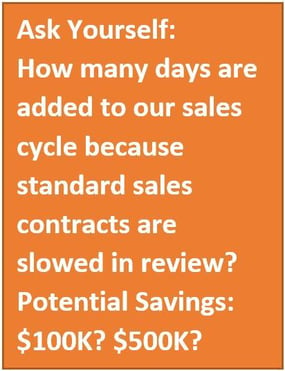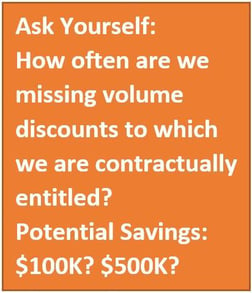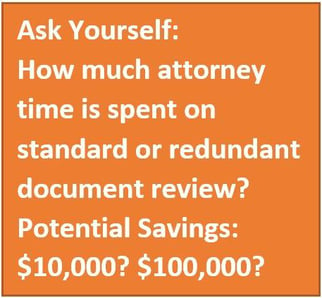Contract Economics 101: Building a Business Case for Contract Management Software System
Post by Dermot Whittaker
As we think about making a business case for contract management software system, it is worth keeping in mind the following high-level observations:
1) The business case for contract managers themselves – along with attorneys and general counsel – is often merely assumed as their value is not always fully understood by more senior management. It is important to make that value explicit. Well-planned, technically enabled contract management software allows these professionals to spend their valuable time applying talent and training to high-value activities as well as managing contracts in the company’s interest.
2) It is rare today to find a company without some form of contract management software. Even organizations that say they have none use spreadsheets to track contract renewals and value, and sometimes even key obligations. Most contracting departments have a goal of keeping electronic versions of the contracts in a central repository; the trouble is often making sure they get there and that amendments and other changes are recorded and attached. Of course, reporting with such arrangements is largely manual. Making the case for contract management software involves showing its increased efficiency over what is in place, and its added functionality in terms of reporting, audit assistance, compliance, document retention, impact on legal holds procedures, etc.
3) Not everything is in the control of a contract management team. A contract’s complexity, the work of earlier negotiators, either party’s ability to deliver on all terms, and even the relationships among the players at different companies: these factors are sometimes givens that a contract management team has to work with. Improvements to efficiency (process) and high-level review of contracts to memorialize "problems solved" or "practices to be avoided in future," on the other hand, are in the control of contract management team members. A contract management software system should substantially increase what is in the control of the contract management team by automating processes to minimize time and effort appropriately, and by providing the means of reviewing contracts in comparative ways and in large numbers.
So, how should we structure the case for contract management software? How should we organize the case? Here are some high-level distinctions to make in the analysis.
Buy Side / Sell Side

The business processes and even the departments and personnel who will use contract management software will be different for these two categories of contracts, buy side and sell side. So will the value derived from the contracts. The Head of Procurement will have different concerns and success criteria from the Vice President of Sales. Ask yourself: Is one side or the other driving the change? Will one side or the other implement the system and need to show ROI first? For buy-side contracts, increased accessibility to (and increased use of) the approved terms regarding price, quantity, volume pricing, delivery, and/or completion will be a goal, ideally leading to better control over spend and reduction in spending relative to a comparable baseline. On the sell side, increased contract volume and shorter time to completion and signing are obvious goals that help to make a case for functionality such as self-service contract creation, automated delivery to and return from the counterparty, and adoption of e-signature. If contract management software can shorten sales cycles, reduce the cost of sales, and result in faster revenue recognition, one can point to money saved over current processes. There is also important – at times crucial -- business value in the increased use of the company’s approved terms by the negotiators who may be using less-than-current language for lack of ready access to revised, approved language.
Pre / Post Execution
Whether forecasting or demonstrating ROI of contract management software, it is important to account for improvements to the process and savings both before and after the contract is signed. From a pre-execution perspective, some easily measurable elements are contract volume, contract cycle time, and personnel time per contract. In regard to personnel time, a common area for savings is the amount of time that highly paid in-house or outside attorneys spend on standard contracts. Once standard language and fallback provisions are in place, a non-attorney should be able to carry the contract to completion more efficiently and at a lower hourly rate. Of course, the attorney’s initial investment of time in approving the standard language and fallback provisions must be taken into account, along with attorney time to review and update these provisions, periodically.
 For contract managers, there may be substantial savings in the time devoted to finding and handling contracts or approved language. An electronic repository of record should hold both executed contracts and those under negotiation, largely eliminating the manual searches for these documents in their current state by the negotiators, managers, and others who need access. A contract dashboard for each team member allows contract managers to see immediately where in the process a contract under negotiation is, allowing them to orient to the task at hand immediately. And an automated workflow that alerts each team member only when their attention to a contract is needed saves time and focuses attention. In a business plan, any quantification of the time spent unnecessarily in the status quo and reduced through the proposed contract management software system helps make a case for the system. Where hours and hourly rates can be applied to this time savings by attorneys and others, ROI can be readily derived (see some simple examples below).
For contract managers, there may be substantial savings in the time devoted to finding and handling contracts or approved language. An electronic repository of record should hold both executed contracts and those under negotiation, largely eliminating the manual searches for these documents in their current state by the negotiators, managers, and others who need access. A contract dashboard for each team member allows contract managers to see immediately where in the process a contract under negotiation is, allowing them to orient to the task at hand immediately. And an automated workflow that alerts each team member only when their attention to a contract is needed saves time and focuses attention. In a business plan, any quantification of the time spent unnecessarily in the status quo and reduced through the proposed contract management software system helps make a case for the system. Where hours and hourly rates can be applied to this time savings by attorneys and others, ROI can be readily derived (see some simple examples below).

The glamour may all seem to be on the pre-execution side of contract management, but savings and increased value can also be powerfully demonstrated on the post-execution side – albeit with more foresight. On the buy side, the clearest area for post-execution savings is a comparison of the negotiated costs of goods and services and the actual costs post-execution. Can analysis of spend under several current contracts reveal lapses where the contracts’ terms, volume discounts, and early renewal discounts were ignored, and expenditures increased by x amount? If you can identify deficiencies like this now, you can point to the savings that effective use of a contract management software system can yield in the future. For both buy and sell side, it may be possible to measure how many contract deadlines (renewal dates, reporting dates, early action dates) are being missed under the current system. Where deadlines are not missed, how many days previous to the deadline are actions taken? While these time measurements do not relate directly to savings, they do demonstrate increased control and agility in the management of hundreds or thousands of such terms in contracts.
More complicated analyses can be made of savings in legal costs post-execution. How often does clear and immediate access to contractual terms result in the resolution of a conflict in your company’s favor? How often are conflicts resolved by reference to quickly findable contract terms without involving highly paid counsel? How often do disputes stay out of court? An important part of any business case should be the greatly reduced legal exposure that use of a contract management software system as the company’s legal repository should afford, where it increases adherence to the standing retention policy.
Easier to Quantify / Harder to Quantify
If the business case for a contract management software system were truly a no-brainer, the investment of time and money in the system would be forthcoming without a second thought. But as with contract management itself, some benefits can be more easily quantified than others.

As noted earlier, some easier-to-quantify measurements of contract management are volume of contracts, time from contract initiation to signature, days to payment (by your company or a counterparty), deadlines met or missed, spend under contract, and legal costs tied to contracts under management. A business case should show how a contract management software system can impact any of these measures positively over the status quo. Harder-to-quantify measurements require more foresight, preparation, discipline or combined calculation – what contract manager doesn’t have these skills! – and include things like personnel time savings on contract drafting and review (by attorney vs. paralegals vs. contract managers, for instance), contract risks identified or mitigated, fines avoided. One problem in making the business case around these harder-to-quantify factors is that without contract management software, reporting on any of these items may be time-consuming, arduous or non-existent. But if you are tracking risks at all in spreadsheets or written reports that take hours to prepare and update, and which are shared among a few by email, the case can be made for electronic systems that allow managers to identify and monitor hundreds or thousands of risks and report their outcomes, sharing the results among users based on security or other criteria.
ROI Basics – Some Examples
First ask: Who are the players?
For purpose of discussion, let’s assume these contract personnel and salaries.
CONTRACT PERSONNEL SALARY RANGE EXAMPLE SALARY (ANNUAL EXAMPLE PAY BY HOUR Attorneys (in-house) $100,000 – $200,000 $150,000 $72.12 Contract Professionals $50,000 – $120,000 $80,000 $38.46 Paralegals, Administrators $34,000 – $70,000 $52,000 $25.00 Thinking about Savings
One can start at a high, speculative level; would contract management software make each team member just 10% more efficient in use of their time? Then for a contracting team of 10 (2 attorneys, 6 contract professionals, 2 paralegals) the 10% improvement would total $88,400 in annual personnel costs (using our example mid-point annual salaries above).
That 10% may simply be an educated guess.1 Can one be more specific, at least as far as efficiency goes?
A Simple Case: Finding a Contract
A simple case everyone has experienced is that of finding a correct, final contract. Using our example salaries above, if it takes a paralegal 5 minutes to find a contract (not just any version, not a reference copy on someone’s laptop, but the final, executed version) that’s $2.08 per contract search. If the search takes 15 minutes (quite possible at large organizations with diverse paper-only repositories, or undisciplined use of intranet repositories) that’s $6.25 per contract. A year’s worth of 2,000 contract searches (some fruitless) by that paralegal could cost between $4,100 to $12,500.
If contract management software helps that paralegal find a contract in 1 minute instead of 5 or 15, it reduces the annual cost of this basic activity by between $3,333 and $11,667.
Now recall that in some situations, contract managers and attorneys often are the ones doing the searching – or directing others to do it and following up – and their rates are higher. A comparable annual cost savings for a contract manager doing the searching with a contract management software system is $5,128 to $17,984, and for an attorney doing her own searching (it’s not unheard of!) $9,616 to $33,656.
OK – annual cost savings of between $3,333 to $33,656 just for using the contract management software to search and find final contracts? That’s a pretty wide range, reflecting our broad estimate of time spent (5 to 15 minutes) and equally broad assignment of the searcher’s pay grade ($25 to $75.12 an hour). The point is that with more precise data from one’s own contracting team, one can arrive a cost and savings estimate that is true to one’s experience and company size. Naturally the estimated savings for any company will depend on its salaries, personnel, contract volume, and work flow.
This very simple example leaves aside the qualitative advantages of a searchable electronic repository such as increased likelihood that the contract will be correctly retrieved the first time.
Another Simple Case – Approving a Standard Contract
If an attorney making $72.12 per hour in our example spends even 15 minutes reviewing a short, standard, low-risk, low-negotiation contract (simply insuring that that the company’s approved language has been adhered to and that no changes have been made by the company’s sales people, or by the counterparty’s attorneys) that’s $18.03 per standard contract reviewed. And if the attorney reviews 1000 such contracts a year, the annual cost is $18,030.
In contrast, a contract professional (making $38.46 an hour in our example) can use a contract management software system to access only approved contract templates and use automatic red-lining to compare versions and confirm that there are no changes to the standard terms. With such a system in place, standard contracts would need little, if any, review by the Attorney. If all of these standard contracts could be reliably reviewed by a contract professional using automatic redlining and adhering to approved language, then the total annual cost would be $9,615, a cost savings of $8,415 a year over use of the attorney for review of the same standard contracts.
Furthermore, the task itself is made less time-consuming and more accurate by the use of automatic redlining that shows all changes to the approved language. If the entire review task, now carried out by the contract professional using contract management software, takes half as long as before, then the annual savings over review by the attorney without contract management software is now $13,223. And if the paralegal is available to do the work instead of the contract professional, the annual savings is $14,905.
How many attorneys are there at your company? How many such standard contracts are they devoting 15 minutes (or 30 minutes, or an hour) to reviewing? If triaging these contracts through use of a contract management software system keeps even half of them off the attorney’s desk, the savings are significant, and the attorney’s time is freed up for higher-level work.
The two examples above focus on efficiency. Contract management software systems facilitate more efficient use of attorney and contract professional time in their use of standard clauses, electronic approval processes and negotiation with external counterparties, contract signing with electronic signature, as well as reporting on contracts in process, approved, or expiring. In our next blog, we’ll look at how contract risks and opportunity – areas of tremendous potential financial loss or gain – can be better managed through the use of contract management software.
Making the Case – Final Thoughts on Value
A business case needs to persuade – honestly. Among the less quantifiable but certainly valuable results of a functioning, configurable, responsive and widely accepted contract management software system is the effect it has on the contracting team and a company’s counterparties, be they clients or suppliers. Contract managers work the tools that facilitate all businesses everywhere. If they have contract management software that empowers them, their expertise and knowledge of the contracts’ uses and terms can grow. Clients will come to rely on a company’s contract managers not simply for their judgment, but for their speed and accuracy. And future mutually beneficial business agreements with counterparties, with less trouble, will be more likely.
"Recent IACCM research suggests that, on average, corporations are losing the equivalent of 9.2% of annual revenue through weaknesses in their contracting process. These losses arise from a combination of missed savings and cost reduction on the one hand, and lost revenue opportunities on the other." ROI of Contract Management. February 2012. IACCM study.
- If you’d like to learn more about our Contract Management Software for businesses that run Microsoft 365, please don’t hesitate to reach out to us or, even better, request a demo and we can show you how it works in real-time.
Contract Economics Blog Series
-
- Introduction
- Part 1 Focusing the Right Human Resources on the Right Business Problem
- Part 2 Leveraging Process and Automation
- Part 3 Building a Business Case for a Contract Management System
- Part 4 Transforming Contracts into Opportunities
-